At the end of the previous part of my travelogue about Thailand, where I travelled at the beginning of 2023, I briefly talked about Thailand’s history and the Grand Palace in Bangkok, which I came to visit. Now, I will focus more on the specific parts of this complex. To begin with, it was quite crowded and I believe it’s a good idea to arrive around 8:30 in the morning when the palace opens, although I’m also sure I’m not the only one who has had this thought. This is one of the must-visit places in Bangkok that is absolutely worth exploring, so crowds are inevitable whenever you come. In other words, dress appropriately (as I’ve mentioned in the previous part) and arm yourself with patience, and then the visiting of the Grand Palace will be one of the highlights of your stay in Thailand.
 Approach to the entrance into the Grand Palace complex
Approach to the entrance into the Grand Palace complex
The Grand Palace is an absolutely impressive place. It practically consists of two large sections that are visited one after the other – first, the large temple complex Wat Phra Kaew (or Wat Phra Kaeo) and then the royal palaces complex.
Looking from the outside, the temple Wat Phra Kaew is a place where a large amount of different structures, figures, details, colours, decorations and impressions are concentrated. Viewed with the “inner eye,” it is the centre of power of the Thai kingdom because the main chapel or the ubosot houses the Emerald Buddha considered the sacred palladium of Thailand. By the way, a palladium is an object believed to have protective power. Thus, the Emerald Buddha is believed to provide legitimacy and ensure prosperity to those who possess it and this is the Kingdom of Thailand.
The entrance to the temple complex leads directly to the rear part of the ubosot with the Emerald Buddha, but I saved the visit to this edifice for later.
 Wat Phra Kaew, a detail
Wat Phra Kaew, a detail
To begin with, I circled the gallery/cloister that surrounds the square courtyard. The reason is that the walls of the gallery are covered with murals that depict the story of Ramakien, the Thai version of the Indian epic Ramayana. The central theme of the story is that the demon king Ravana (in Thailand, Thotsakan) abducted Rama’s wife Sita, hoping that she would fall in love with him, which did not happen. In the meantime, Rama, who was a prince and the avatar of god Vishnu, sets out in search of his wife, and various adventures and battles unfold. Ultimately, Rama defeats his greatest enemy Ravana and brings his wife back home. All of this, in much more detail, is visually portrayed through 178 murals. The paintings were first created during the reign of King Rama I (b/r 1737/1782-1809) and since then they have been regularly maintained and, when necessary, restored.
 Wat Phra Kaew, a detail
Wat Phra Kaew, a detail
The reason for the significance given to the story of Prince Rama is that his adventures and misadventures on the journey to free his wife illustrate his virtuous relationship with duties toward the family, the wife and the kingdom. In this way, Prince Rama embodies an ideal ruler and, in the case of Thailand, his Hindu connection to god Vishnu fades, while emphasising precisely this aspect of an ideal and just king. It is not by chance that the kings of Thailand use the name Rama, which almost takes on the function of the title of an ideal ruler as the members of the ruling Chakri dynasty wish to see themselves.
But let me get back to the murals. To follow the story, it is necessary to move in a clockwise direction and I did go around the entire circle, although I certainly didn’t take photos of everything. Still, I was quite impressed, and here is a small part of these beautifully crafted paintings.
 Wat Phra Kaew, a detail
Wat Phra Kaew, a detail
 Wat Phra Kaew, a detail
Wat Phra Kaew, a detail
 Wat Phra Kaew, a detail
Wat Phra Kaew, a detail
 Wat Phra Kaew, a detail
Wat Phra Kaew, a detail
 Wat Phra Kaew, a detail
Wat Phra Kaew, a detail
 Wat Phra Kaew, a detail
Wat Phra Kaew, a detail
 Wat Phra Kaew, a detail
Wat Phra Kaew, a detail
The entire gallery, except for a few open passages, is covered and protected from the strong sun, which is excellent for the paintings and was also good for me because it was starting to get hot.
 Wat Phra Kaew, a detail
Wat Phra Kaew, a detail
The Wat Phra Kaew Temple with its numerous larger and smaller chapels and shrines is a place that tourists should definitely visit during their stay, but it is also an active temple, so many Thais and Buddhists come here to make offerings and pray. Many of the offerings are made of fresh flowers.
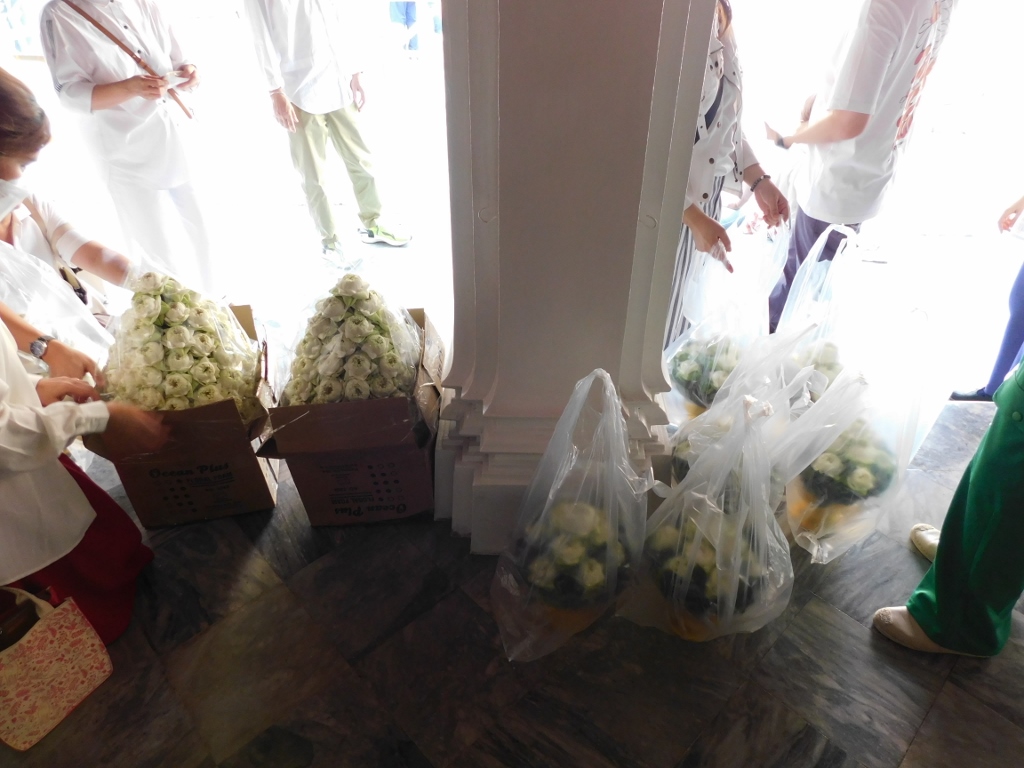 Wat Phra Kaew, a detail
Wat Phra Kaew, a detail
And so, after completing the entire circle around the gallery, I reached the main entrance to the temple complex, where there is also a shrine set behind the rear of the Ubosot with the Emerald Buddha. The central figure within the shrine is the statue of the Hermit, also known as Cheewok Komaraphat, who was Buddha’s physician. He is considered the father of Thai herbal medicine and is also the patron saint of Thai medicine in general.
 Wat Phra Kaew, a detail
Wat Phra Kaew, a detail
Just like at all other places designated for prayer, lighting of incense sticks and providing offerings, here too, one can see numerous small wreaths made of fresh flowers.
 Wat Phra Kaew, a detail
Wat Phra Kaew, a detail
From the direction of the shrine with the Hermit, the entrance to the courtyard through which I entered is also clearly visible.
 Wat Phra Kaew, a detail
Wat Phra Kaew, a detail
So, the gallery with the wall paintings extends to the left and right of that entrance. There are also the yakshas, huge demon guardians, placed at the entrance. There are a total of six pairs of them and they all face the chapel with the Emerald Buddha, guarding it from evil spirits. The yaksha statues were erected during the reign of Rama III (b/r 1788/1824-1851, and each of them represents an important character from the Ramakien story.
 Wat Phra Kaew, a detail
Wat Phra Kaew, a detail
 Wat Phra Kaew, a detail
Wat Phra Kaew, a detail
Now, I started to go around the Ubosot of the Emerald Buddha in order to reach the main entrance and along the way I took photos of a couple of more yakshas and the Phra Si Rattana Chedi that I visited later on.
 Wat Phra Kaew, a detail
Wat Phra Kaew, a detail
 Wat Phra Kaew, a detail
Wat Phra Kaew, a detail
I directed my attention now to the Ubosot of the Emerald Buddha. The next photo was taken a bit later, but it serves well to show a part of the Ubosot and demonstrate the size of this impressive structure.
 Wat Phra Kaew, a detail
Wat Phra Kaew, a detail
I have already mentioned before that “ubosot” is a term used in Thai architecture to refer to the central building within a temple complex. This structure is often called the “main chapel,” but most often it is referred to as the “ordination hall.” This concrete ubosot is traditionally used for the ordination of the male members of the royal family. As I’ve mentioned earlier, in Thailand, it is a tradition for men to spend at least a part of their lives as Buddhist monks from the age of 20 onwards and this applies to the members of the royal family, too.
In the photos, you can also see that the ubosot has a three-tiered roof, clearly indicating that this is a royal temple, since local and less important temples usually have single- or double-tiered roofs. Although the ubosot has undergone some modifications over time, it remains essentially as envisioned by King Rama I.
Here are a few more photos of the ubosot that I took during my walk around the area.
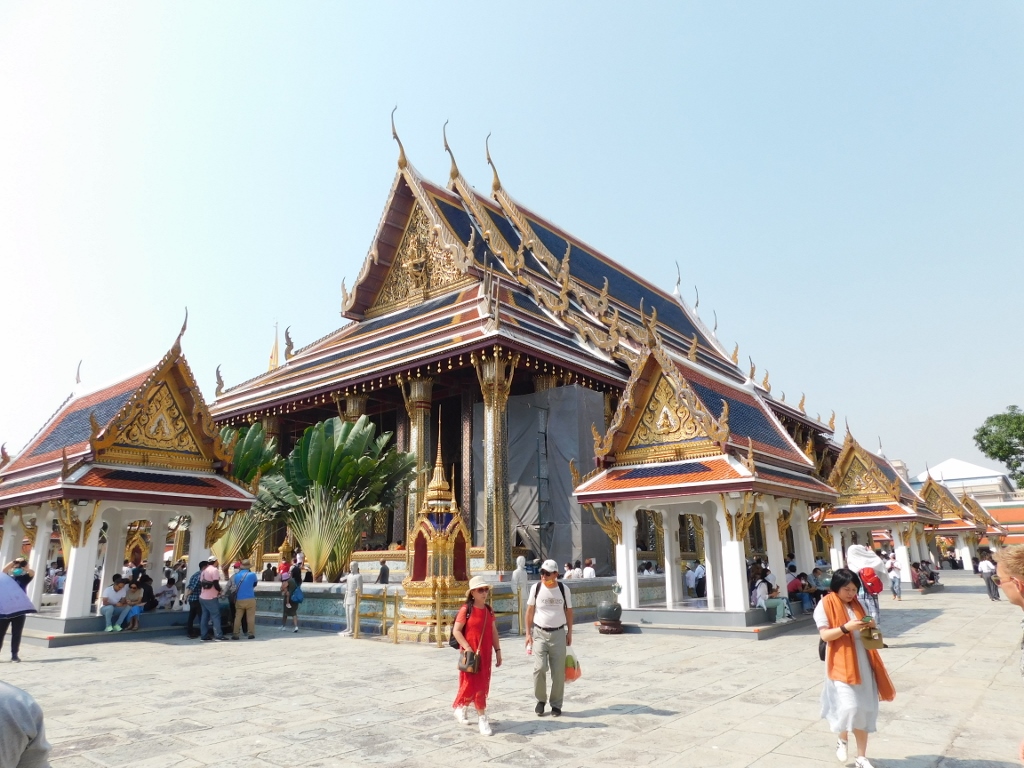 Wat Phra Kaew, the ubosot
Wat Phra Kaew, the ubosot
 Wat Phra Kaew, the ubosot
Wat Phra Kaew, the ubosot
The previous photo shows the facade of the temple, while on the following one, you can see the side part of the temple with shelves for leaving shoes. As is customary in all temples in Thailand, it is not allowed to enter inside wearing shoes and here, due to the large number of visitors, there are shelves provided. In less visited temples, shoes are usually just left at the entrance.
 Wat Phra Kaew, the ubosot
Wat Phra Kaew, the ubosot
As it can be seen from the previous photographs, the ubosot of the Wat Phra Kaew temple is exceptionally opulently decorated. The entire exterior of the ubosot is adorned with gilded, glass and other intricate details.
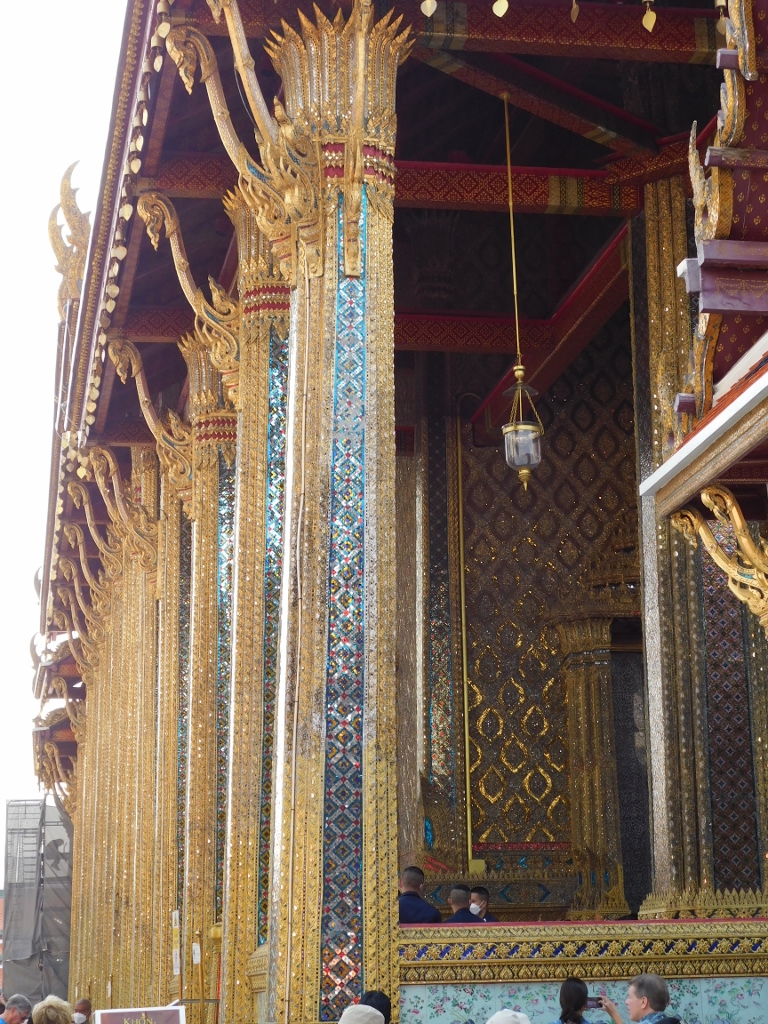 Wat Phra Kaew, the ubosot, a detail
Wat Phra Kaew, the ubosot, a detail
 Wat Phra Kaew, the ubosot, a detail
Wat Phra Kaew, the ubosot, a detail
 Wat Phra Kaew, the ubosot, a detail
Wat Phra Kaew, the ubosot, a detail
Among other things, the ubosot is adorned with a series of 112 golden Garudas. Garuda is a Hindu demigod representing the vehicle of Lord Vishnu, once again creating a connection with the mythical prince Rama as the fourth avatar of god Vishnu. The term “avatar” here refers to the manifestation of a deity in human form, signifying the incarnation of a divine teacher.
 Wat Phra Kaew, the ubosot, a detail
Wat Phra Kaew, the ubosot, a detail
And yet, no matter how impressive the exterior of the ubosot may be, the central object of worship is the Emerald Buddha located inside. The next photograph shows a view of the central staircase, a crowd of people already inside and a bit further into the shadows the figure of the Emerald Buddha.
 Wat Phra Kaew, the ubosot, a detail
Wat Phra Kaew, the ubosot, a detail
The interior of the ubosot is equally impressively decorated as the exterior, but here all eyes are directed towards the Emerald Buddha.
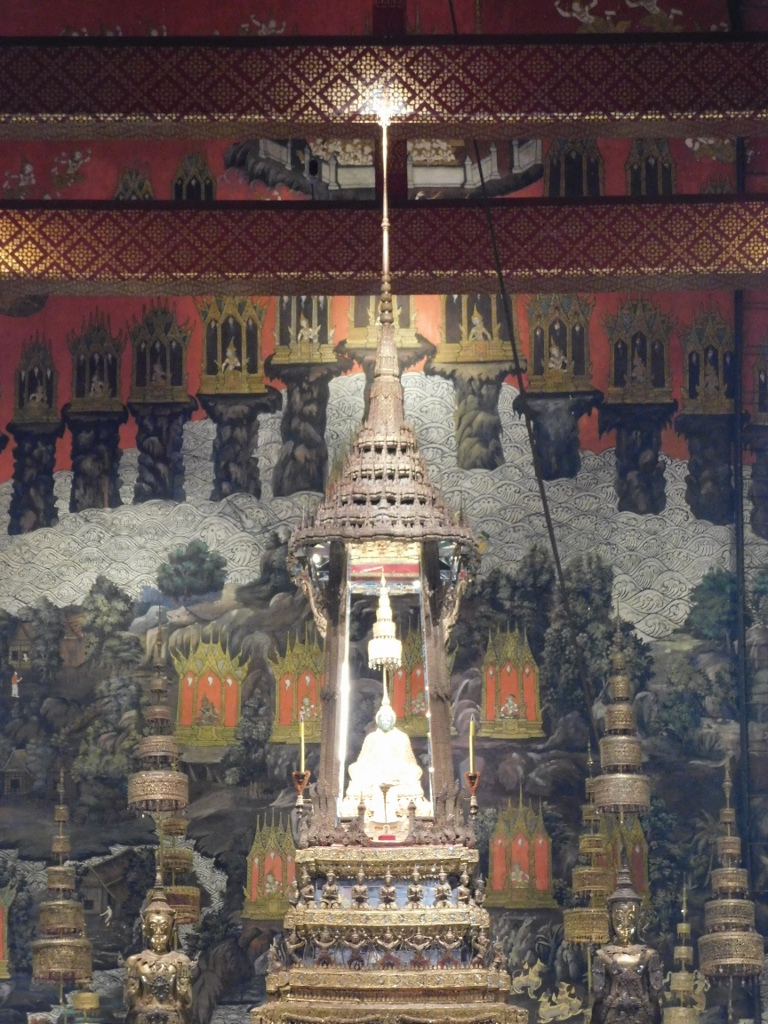 Wat Phra Kaew, the ubosot, a detail
Wat Phra Kaew, the ubosot, a detail
This is a sculpture of the Buddha seated in a meditation posture. The sculpture is 66 cm tall, but despite the name, it is not made of emerald or even jade, but rather of semi-precious green jasper, carved from a single piece. Judging by the style, the Emerald Buddha was crafted in northern Thailand, likely in the 15th century. This is the most important Buddha statue in Thailand.
The sculpture is elevated on a multi-tiered structure with intricate details. It was interesting to learn that the Emerald Buddha has its clothes changed three times a year to correspond with Thailand’s seasons: summer, rainy season and winter. I was here apparently in the middle of winter and the Emerald Buddha was dressed in a costume made entirely of gold and precious stones.
 Wat Phra Kaew, Emerald Buddha
Wat Phra Kaew, Emerald Buddha
Having walked through the ubosot and having taken photos of the Emerald Buddha, I strolled over to a structure I had only briefly glimpsed beforehand and that was the Phra Si Rattana Chedi. As I’ve mentioned earlier, a chedi is a Thai Buddhist monument equivalent to the Indian stupa. Both structures often have a bell-like shape and typically at their base enshrine the relics of the Buddha or other holy figures.
The Phra Si Rattana Chedi was erected in 1855 and inside it holds the relics of the Buddha. Originally painted white, the chedi later received a golden coating.
 Phra Si Rattana Chedi
Phra Si Rattana Chedi
The Phra Si Rattana Chedi is placed on an elevated platform, so I climbed up there to get a different perspective and capture some details.
 Wat Phra Kaew, a detail
Wat Phra Kaew, a detail
 Wat Phra Kaew, a detail
Wat Phra Kaew, a detail
And then, from the platform, I started descending to the courtyard level because there were more structures to visit.
 Wat Phra Kaew, a detail
Wat Phra Kaew, a detail
First, I came to a structure called the Hor Phra Naga. The original building with this name was erected by Rama I in order to house a standing Buddha statue, but over time, that statue was moved to a neighbouring structure, while here the ashes of deceased princes and princesses are kept.
 Hor Phra Naga
Hor Phra Naga
That neighbouring structure is the Vihara Yod, built by Rama III to house not only the Buddha statue from the Hor Phra Naga, but also many other Buddha statues. It couldn’t be seen as the entrance was closed, but next to the entrance, you can notice a decoration made of pieces of coloured porcelain.
 Vihara Yod
Vihara Yod
 Vihara Yod, a detail
Vihara Yod, a detail
The next structure I came across was the auxiliary library where numerous Buddhist scriptures are kept.
 Auxiliary library at Wat Phra Kaew
Auxiliary library at Wat Phra Kaew
 Auxiliary library at Wat Phra Kaew
Auxiliary library at Wat Phra Kaew
The main library of the Wat Phra Kaew temple, where a large number of Buddhist manuscripts are kept, is housed in a structure called the Phra Mondop. During my visit, it was covered by scaffolding, indicating ongoing renovations. This building, along with the Phra Si Rattana Chedi and the next structure I went on to explore, is situated on the elevated platform I’ve mentioned earlier – the Upper Terrace.
So, now I dealt with the structure known as the Prasat Phra Thep Bidon or the Royal Pantheon. I first approached it from the side and then ascended to the Upper Terrace for a closer look at the details. They were impressive!
 Prasat Phra Thep Bidon
Prasat Phra Thep Bidon
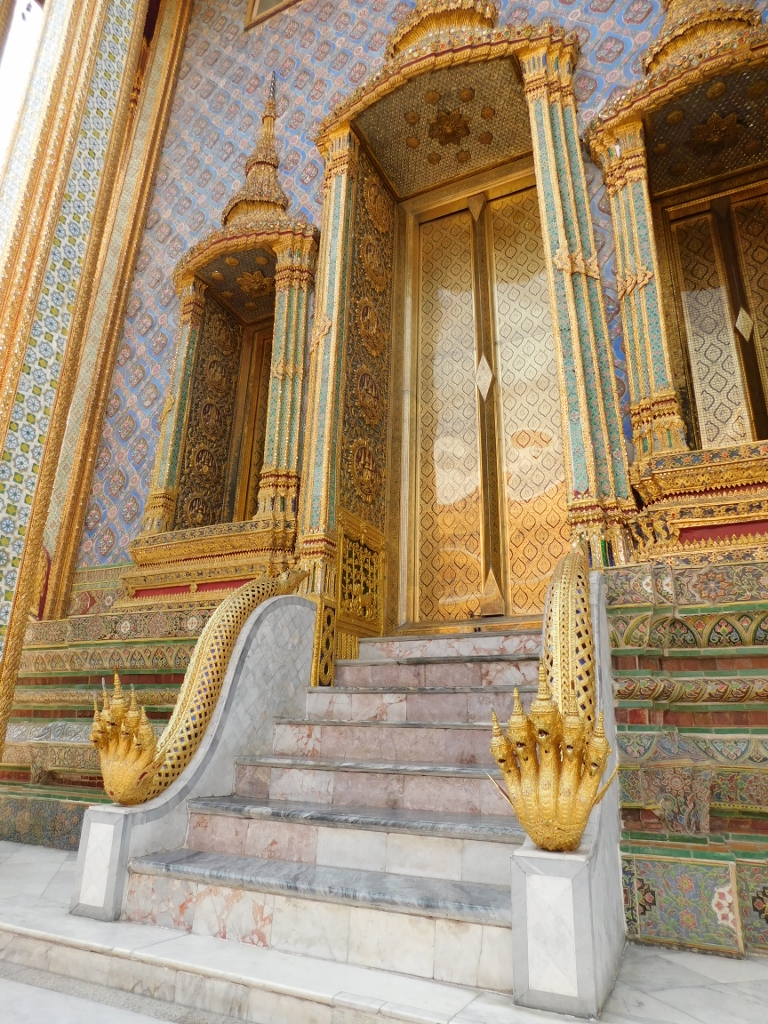 Prasat Phra Thep Bidon, a detail
Prasat Phra Thep Bidon, a detail
 Prasat Phra Thep Bidon, a detail
Prasat Phra Thep Bidon, a detail
I then briefly descended from the terrace to get a better view of the facade of this pavilion from the courtyard level. Later, I ascended again to approach the structure and examine more details, which were truly spectacular from this vantage point as well.
 Prasat Phra Thep Bidon
Prasat Phra Thep Bidon
 Prasat Phra Thep Bidon, a detail
Prasat Phra Thep Bidon, a detail
 Prasat Phra Thep Bidon, a detail
Prasat Phra Thep Bidon, a detail
The construction of the original structure began in 1856 by King Rama IV (b/r 1804/1851-1868), with intention to relocate the Emerald Buddha here. However, this plan fell through and over time statues of the Thai kings from the Chakri dynasty found their place in this pavilion. Therefore, this pavilion, built in the early 20th century after the first one was destroyed in a fire, became a sort of memorial monument. It currently houses nine life-sized statues of the Thai kings, hence the English term “Royal Pantheon.”
Since I couldn’t see this due to the pavilion being open only one day a year, I paid attention to the surroundings, where there are also two chedis built by King Rama I in memory of his parents.
 Two chedis and between them the front facade of the Royal Pantheon
Two chedis and between them the front facade of the Royal Pantheon
King Rama V (b/r 1853/1868-1910) added the figures of yakshas (giants) and Hanuman to these chedis. They are arranged as if supporting the chedis, because they in fact symbolically hold up the entire world on their arms.
 Chedi at the Royal Pantheon
Chedi at the Royal Pantheon
By the way, both yakshas and Hanuman are important characters in the Thai epic Ramakien. Hanuman is a Hindu deity with a human body and a monkey’s head. He is a loyal assistant to hero Rama, so his presence in the Thai version of the Ramayana is quite normal. Here, on the chedis, Hanuman’s figures are easily noticeable as they are red, unlike the yakshas. Another important detail that distinguishes them is that the divine monkey doesn’t have footwear, unlike the demons or yakshas.
 Chedi at the Royal Pantheon
Chedi at the Royal Pantheon
On the Upper Terrace, you can also notice figures of mythical beings made of bronze and gilded with gold leafs, seven pairs in total, one pair of each type. They are all celestial beings from Hindu-Buddhist mythology, depicted as half-human, half-animal. A couple of these figures were visible in some of the previous photos and here are some more.
 Mythological beings near the Royal Pantheon
Mythological beings near the Royal Pantheon
From the Upper Terrace, the eastern part of the courtyard can be clearly seen, featuring eight towers known as the prang. These are versions of chedis, constructed during the reign of Rama I, but covered with softly coloured porcelain during Rama III’s era. Like the chedis, the prang serve as monuments dedicated to someone worthy of veneration. While one of these eight is dedicated to Gautama Buddha, the others are dedicated to various Buddhist concepts or aspects – the Dharma or Buddhist scriptures, male Buddhist monastics, female Buddhist monastics, etc.
 Two prang and between them a gate with yakshas
Two prang and between them a gate with yakshas
 Gate with yakshas
Gate with yakshas
I now definitely descended to the courtyard level, continuing to marvel at the incredibly large number of details. For most of them, I don’t even know their meaning or symbolism, but that didn’t stop me from enjoying them.
 Wat Phra Kaew, a detail
Wat Phra Kaew, a detail
 Wat Phra Kaew, a detail
Wat Phra Kaew, a detail
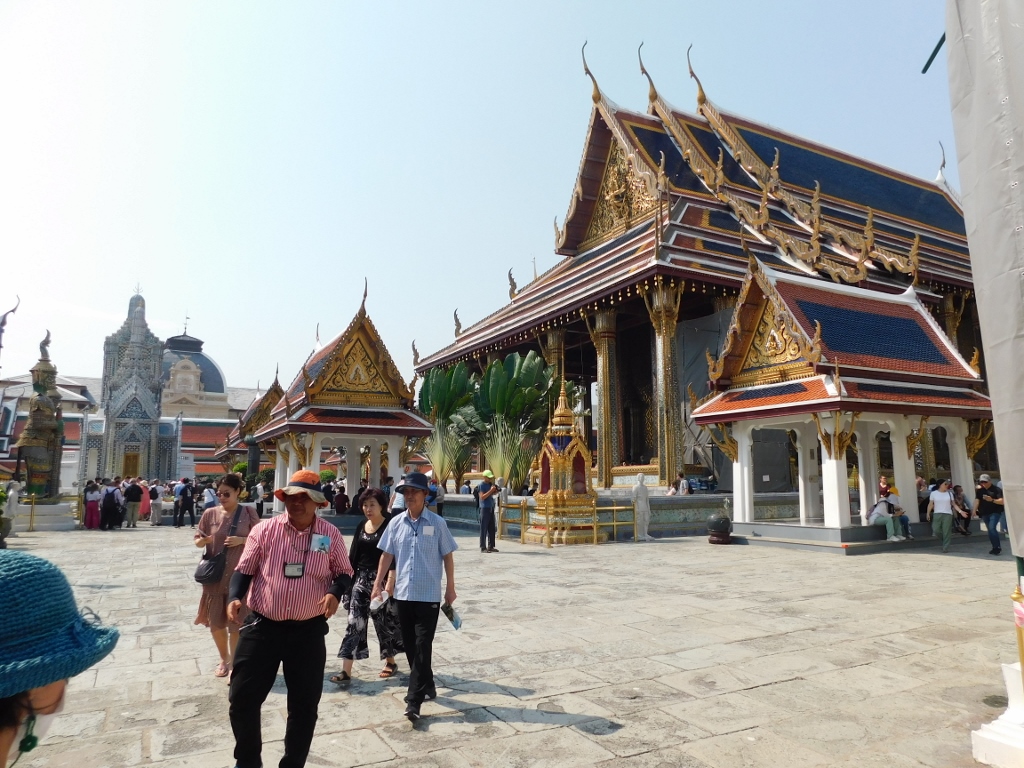 Wat Phra Kaew, a detail
Wat Phra Kaew, a detail
Then I returned to the front of the ubosot, scrutinising some details and observing the surroundings. In the next photo, for instance, on the left-hand side, the roofs of two salas are visible and behind them is the pediment of the ubosot, while on the right-hand side, one of the pair of chedis with figures of yakshas and Hanuman can be seen, as well as the impressive Prasat Phra Thep Bidon or the Royal Pantheon.
 Wat Phra Kaew, a detail
Wat Phra Kaew, a detail
The photo clearly shows the roof of the Royal Pantheon and on the basis of it one can infer why this building is called prasat. Namely, in Thai architecture, this term is given to the royal palaces or sacred religious structures with elaborately decorated roofs, usually multi-tiered, and with one or more pointed towers or spires, symbolising the centre of the universe. I mention this not to show off, but rather because these terms often come up when touring Thailand, so it’s better to explain them now and use them later than to describe them every time.
 Shrine in front of the ubosot of Wat Phra Kaew
Shrine in front of the ubosot of Wat Phra Kaew
 Wat Phra Kaew, a detail
Wat Phra Kaew, a detail
 Wat Phra Kaew, a detail
Wat Phra Kaew, a detail
I definitely must have skipped seeing and mentioning a multitude of details here, but there are so many that I think a Ph.D. in Thai Buddhism and Thai architecture is needed to pay attention to everything.
In any case, I finished touring Wat Phra Kaew and now I headed towards the Grand Palace, but along the way, I took a few more photos of the ubosot and its details, as well as of the immediate surroundings.
 Wat Phra Kaew, a detail
Wat Phra Kaew, a detail
 Wat Phra Kaew, a detail
Wat Phra Kaew, a detail
I just want to mention that the salas, 12 of them, are open pavilions surrounding the ubosot and they were built during the reign of Rama I so that the worshippers could sit there and listen to the sermons and chants from the ubosot.
 Wat Phra Kaew, one of the salas
Wat Phra Kaew, one of the salas